Last Updated on April 23, 2023
Going for a designer dog is a brave decision as it means you would never know what you’re going to get.
But the Labrador Retriever and Poodle mix, which is also known as the American Labradoodle, Labradorpoo, Labradordoodle, Labrapoo, Labrapoodle, and Labbidoo, is one of the most popular hybrids.
Aside from getting incredible traits from its parents, let’s find out why everyone is falling in love with the Labrador-Poodle mix breed.
Quick Navigation
- 1 The History of The Labradoodle
- 2 Shaggy Doodle Generations
- 3 Labradoodle Association and Recognition
- 4 What Does An American Labradoodle Look Like?
- 5 The Personality of the Labradoodle
- 6 Taking Care of a Poodle-Labrador mix
- 7 Where to Find the Perfect Labradordoodle and How Much are They?
- 8 Is the Labradoodle the Right Dog For You?
- 9 Further reading: Other Adorable Doodles
The History of The Labradoodle
Back in 1989, the Royal Guide Dogs Association of Australia were attempting to create a hypoallergenic guide dog for a woman in Hawaii who is blind and has a husband that’s allergic to dogs.
The breeders decided to cross the Standard Poodle, for its reputation of having an allergy-friendly coat, with a Labrador Retriever, who’s known for its suitability as a guide dog, to fulfill the woman’s request.

And it resulted in the birth of the first litter of Standard Labradordoodles.
The puppies’ saliva and coat samples were sent to the Hawaiian couple to test it out. Alas! One of the three pups of the litter, Sultan, passed the allergy-test!
They trained Sultan to be the service dog of the blind woman and to be their companion. After that, the Lab and Poodle cross just became more famous.
But since I mentioned the term Standard, let us also learn what it means and the basics about the Labradoodle’s generations.
Shaggy Doodle Generations
Mixing two purebred dogs would mean that the offspring can have similar qualities from their parents, but it doesn’t necessarily mean that it’s 50/50 or balanced.
Sometimes, the puppy can inherit more characteristics from one of the parental breeds than the other. Besides, there are a lot of ways breeders can produce Labradoodle varieties.
The F1 or First Generation puppies is where you cross a Labrador to a Standard Poodle. F1 offsprings, in this case, is what we know as the First Generation/Standard Labradordoodles.
Next to that is the F1B or Back Cross. It is when you mix an F1 or a Labradoodle back to a Poodle.
Then the bloodline goes on when you get the last offspring and mix it with another Labradoodle. The farther or higher the generation is (F2, F3, and Multigeneration puppies), the better because that is how breeders achieve consistent qualities in a breed.
Here’s a chart that shows the generation, the mixes involved, and the offspring:
| Generation of Puppies | Parent’s Mixed | Offspring |
|
F1 |
Standard Poodle |
First Generation or Standard Labradoodle |
|
F1B |
F1 Labradoodle |
F1B Labradoodle |
|
F2 |
Both F1 Labradoodles | F2 or Second Generation Labradoodle |
|
F2B |
F2 Labradoodle |
F2B Labradoodle |
|
F3 |
Both F2 Labradoodles | F3 or Third Generation Labradoodle |
|
Multigens |
Both F3 or higher generation (F4, F5) Labradoodles |
Australian Labradoodles* |
*The Aussiedoodle is much more advanced as the developers of the breed infused other breeds aside from the Lab and Poodle.
They also added the American Cocker Spaniel, the English Cocker Spaniel, the Irish Water Spaniel, and the Curly Coat Retriever.
Labradoodle Association and Recognition
Being a hybrid, the American Kennel Club (AKC) does not recognize the Labrador-Poodle cross. But some organizations are pushing to get this dog certified as its own breed.
Some of the clubs or associations that recognize the Labrapoodle are:
- ACA = American Canine Association Inc.
- ACHC = American Canine Hybrid Club
- DBR = Designer Breed Registry
- DDKC = Designer Dogs Kennel Club
- DRA = Dog Registry of America, Inc.
- IDCR = International Designer Canine Registry
- Australian Labradoodle Association
- International Australian Labradoodle Association
What Does An American Labradoodle Look Like?
This teddy bear-looking dog has large and expressive eyes that are sometimes round or oval. They seek eye contact with their human which really sets the bond between them.
Labradoodles have eye colors that can be dark brown, shades of hazel, or honey color. Having very long eyelashes is one of the distinct features of this breed. It keeps the long coat away from the dog’s eyes so you should never cut their lashes.
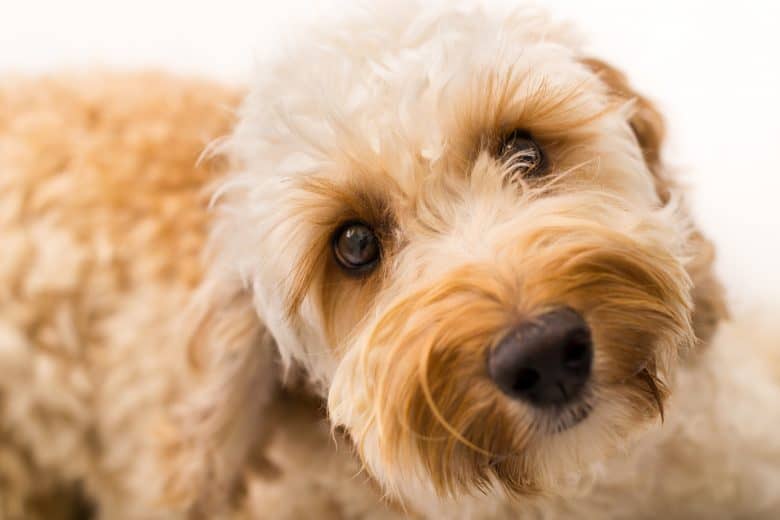
Their ears are low on the head and can’t stick out or up, and lays flat. A Labradoodle’s nose looks like a large square with a fleshy appearance. Did you know that their nose color depends on the coat color as well?
Here are some of the Labradoodle colors with their respective nose colors:
- Caramel and Chocolate Labradoodles – have rose or liver-colored noses
- Black, Silver, Apricot, Red, and Gold Labradoodles – have black noses
- Cream-colored Labbidoos – can have black, rose, or liver noses
- Blue Labrapoodles – should have bluish black noses
A Labbidoo’s tail is never docked and should not entirely curl upon itself and should be saber-shaped like the Labrador’s.
But some of these dogs may have a tail that is swirling over the back.
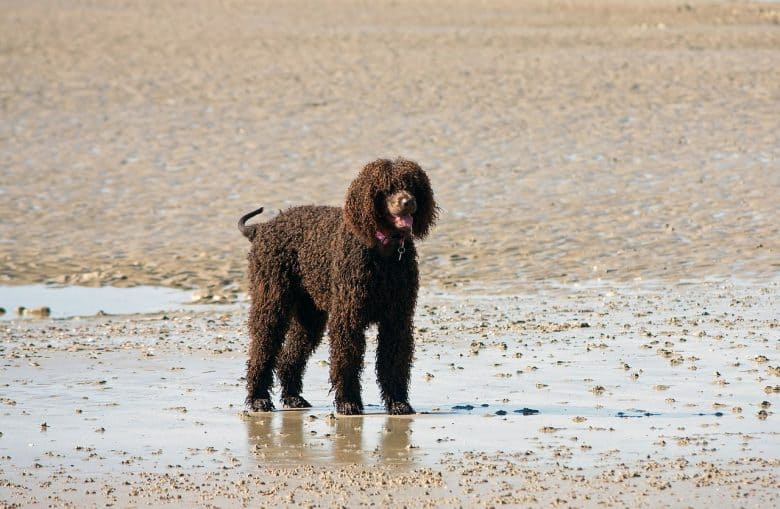
Labrador-Poodle mix Coat Types
This breed has three coat types that differ in texture:
- The Hair Coat– This is the least popular as it is similar to the fur of shedding breeds, and they usually have that doggy odor. It can be curly, wavy, or straight.
- The Wool Coat– This has tight curls like the Poodle’s but is much softer. Unlike the hair, it’s hypoallergenic and doesn’t have that doggy smell.
- The Fleece Coat– Is also suitable for allergy sufferers and ranges from straight to wavy. It has that soft and silky texture like an Angora.
Labradordoodles only have a single coat with curls that aren’t too tight, and it shouldn’t be fluffy or thick.
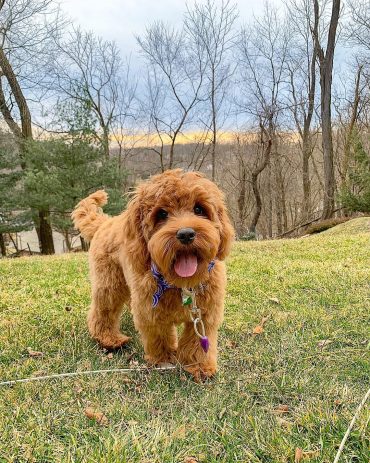
The Labrapoodle’s Size
You can cross a Labrador to a Standard-sized, Medium, or Miniature Poodle, that is why their Labradoodle offspring also comes in three size variations.
Standard Labradorpoos should be around 21 to 24 inches (53 to 61 cm) in height and can weigh from 50 to 65 pounds (23 to 29 kg).
Medium Labbidoos are about 17 to 20 inches (43 to 51 cm) high and 30 to 45 pounds (14 to 20 kg) in weight.
The Miniature or Mini Labradoodles are only 14 to 16 inches (36 to 41 cm) tall and 15 to 25 pounds (7 to 11 kg).
Here’s a comparison chart of the different sizes of a Poodle & Lab cross:
| Size | Height | Weight |
| Standard Labradoodle |
21 to 24 inches |
50 to 65 pounds |
| Medium Labradoodle |
17 to 20 inches |
30 to 45 pounds |
| Miniature Labradoodle |
14 to 16 inches |
15 to 25 pounds |
The kind of home that Labbidoos are suited for will depend on the size of the dog that you have. What’s important is that you’d be able to give your Doodle daily exercise.
The Personality of the Labradoodle
Labradoodle puppies that are bred and raised well have excellent temperaments. They are curious, playful, and friendly. But they are happiest whenever their favorite human or family is around them.
Aside from being a popular and terrific family dog, the energetic Poodle and Lab mix is also suitable for owners who enjoy being active.
If you’re looking for an excellent therapy or guide dog, the search is over because the Labradoodle is a perfect candidate.
And not only is this breed good with kids, but it’s also great with other dogs and pets! Fair warning though, the Lab & Poodle cross can be exuberant at times and may unintentionally bump your little one.
Just make sure to always supervise when the children and the dog are playing together.
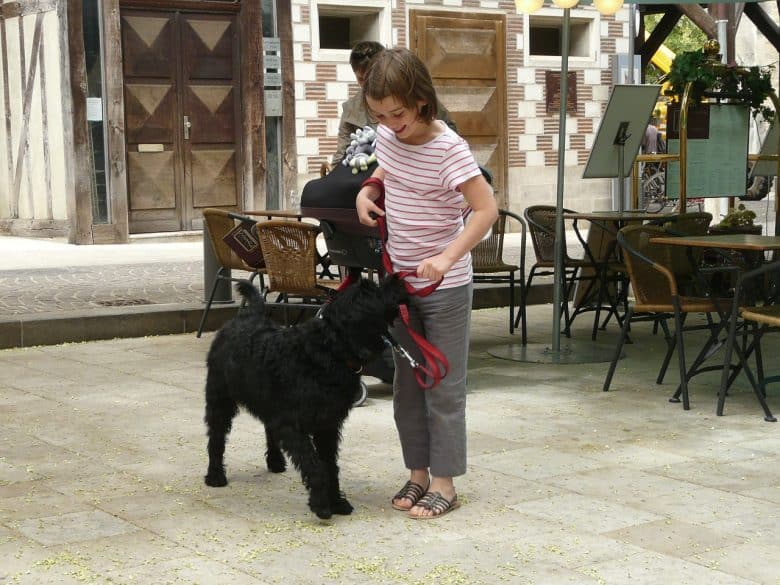
How much exercise does a Poodle-Lab mix need?
Generally, Labradoodles have a moderate to high activity level. They require about 30 minutes to an hour of exercise a day.
Labradoodles enjoy the great outdoors, and like their Poodle parent, this breed loves the water. They can even be athletic enough to join sports for dogs like obedience, agility, and rally!
We know that they can be your next jogging companion, but Labradoodles need time off the leash to burn off steam on their own. They’d be perfect for homes that can provide them a safe space, like a fenced yard, to release their pent-up energy.
Exercise is also very beneficial, not only for its health but also for this dog’s emotional development.
If your Labrapoodle feels stressed, lonely, or even overly stimulated, she will let you know by barking. Don’t worry because a little exercise and affection can fix that.
How to Train a Smart Dog Like the Labradoodle
Thanks to the intelligent Poodle and the eagerness to please the Lab, their offspring inherited those amazing traits and is generally easy to train.
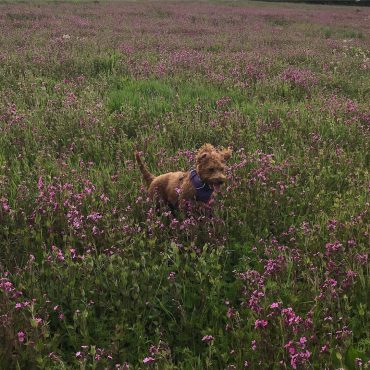
Start with socialization by exposing your Labradordoodle puppy to positive experiences.
You can have people over from time to time or let your puppy meet new people during your walks. Take her shopping in stores that allow dogs, spend some time in busy parks, or even enroll her in puppy kindergarten classes.
As long as you are consistent and are using positive reinforcement, it would polish your Labradoodle’s social skills. You should not only teach her housebreaking or crate training, but you should also teach her proper doggy etiquette.
Whether you’re at home or visiting someone else’s house, your dog should know the basic rules. She should know how to act around other people, as well as where to go and what signs to give if she needs to go.
All dogs need mental and physical stimulation to grow up into well-rounded dogs.
If you do not spend time training your Labradordoodle, and you do not correct her naughty acts, she might get out of control and can be destructive.
Taking Care of a Poodle-Labrador mix
The average lifespan of the Labradoodle is 12 to 14 years. If you want to spend more time with your dog and exceed her life expectancy, it’s not impossible when you give her proper care, inside and out.
You have to make sure that she gets the care and nutrition she needs, and be aware of the possible health problems that your Labrador-Poodle cross may encounter.
How to Properly Groom Your Labradoodle
Your dog’s grooming needs would vary depending on the type and length of coat that she has.
The Labrador Retriever and Poodle cross doesn’t require frequent bathing unless you want the coat to be felt. Once every three months is enough.
There is one trick that Labradoodle owners must know. If your dog gets muddy, just let it dry and then brush her coat. You’d be surprised to see how clean she is while the debris drops off of your Doodle with every stroke of a dematting rake!
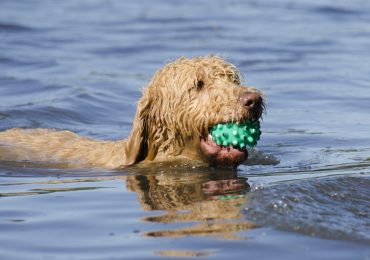
If your Labbidoo is mostly indoors, you only need to brush her coat every couple of weeks. If she’s outdoorsy, you may have to do a weekly brushing.
Once your Labradordoodle pup is around 8 months old, regular brushing is needed to strip out all the puppy coat and avoid it from tangling and getting matted in the adult fur.
Start brushing your Lab and Poodle cross from the feet first, working your way up to her body and face using a slicker brush. Deal with one section at a time, stopping on parts with tangles.
Then run a comb to detect smaller tangles. Keep combing her fur to make sure every section of her body is tangle-free.
It’s okay to need help from a professional groomer to trim and clip your dog. Bringing her in every 6 to 8 weeks will keep the coat easy to maintain. It can cost around $45 to $75, depending on what you want.
Read our article about 9 Labradoodle Haircuts to help you decide which hairstyle is best for your pet.
For your Labradoodle’s ear care, do a weekly check and make sure that they’re dry and clean.
Wiping her ears using a cotton ball dampened with a vet-prescribed pH-balanced cleaner can help keep infections or problems at bay.
All Doodles tend to have hair growing inside their ear, and you would need to pluck them out for better air circulation.
Here’s a video showing how to do ear plucking properly if you haven’t seen or done it before:
You should also brush your Lab-Poodle mix’s teeth at least 3 times a week and trim her nails when you hear them clicking against the floor.
Make grooming a pleasant experience. If you need to include treats, do it!
Diet Requirements for Labradoodles
Keep in mind that how much a canine needs to eat would depend on a lot of factors – size, age, build, and activity level. For your Labradoodle, feed her 1 to 2 ½ cups of high-quality, dry dog food a day and split it into two feedings.
Splitting meals would keep your dog from getting bloated, or worse, overweight.
You would know if your doodle is not overweight if you can see her waist and feel her ribs without putting pressure.
If you can’t feel her ribs, then that means your Poodle-Labrador cross would need less feeding or more exercising.
Keep your Labbidoo at an appropriate weight, and it will play a significant role in extending your dog’s life.
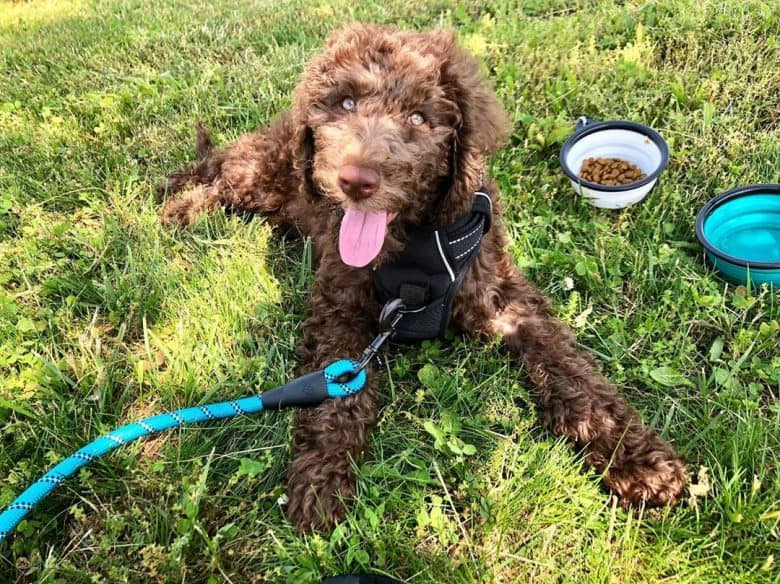
Is the Labradoodle a healthy breed?
The Labrador Retriever and Poodle mix are generally healthier than their purebred parents, as they benefit from having hybrid vigor.
The term hybrid vigor means the improved vitality of the offspring of two different breeds. But that doesn’t mean the crossbreeds are not prone to specific health issues.
The Labrapoo may be susceptible to the health problems that Poodles (Standard or Miniature) and Labradors suffer from, some of them are:

- Elbow and Hip Dysplasia
- Allergies
- Ear Infections
- Epilepsy
- Diabetes Mellitus
- Progressive Retinal Atrophy
- Sebaceous Adenitis
- Hypothyroidism
The health problems listed here don’t mean that all Labradordoodles will get them, but it’s vital for anyone who owns a dog to be aware of what their canine friend might face.
Make sure your Lab-Poodle mix is healthy in all aspects so you two can spend more time together.
Where to Find the Perfect Labradordoodle and How Much are They?
A breed’s popularity means it’s easier and cheaper to find them, right?
Wrong!
The Labrapoodle’s vogue encouraged unethical and careless breeding from people who aren’t familiar with or don’t even care about proper breeding practices.
Be sure to invest time in doing your research when looking for a reputable Labradoodle breeder.
But before counting your budget to buy a puppy, we highly recommend that you choose to rescue or adopt.
You’d be saving a life of a fur angel and you’d be giving that dog a chance to feel loved. Not only that, but it’s also a lot cheaper to pick rescues since adopting a Labrador Retriever-Poodle cross would only cost around $300.
If you opt to buy, some factors can affect the price, like lineage, quality, location, etc.
Generally, a Labradoodle puppy would cost anywhere from $500 to $2,500.
Registered and Reputable Breeders
A reputable breeder who has nothing to hide is proud of their dogs and facilities.
Their canines should be staying in a safe, clean, and comfortable environment, that you can take as a hint that the pups are well taken care of and are healthy.
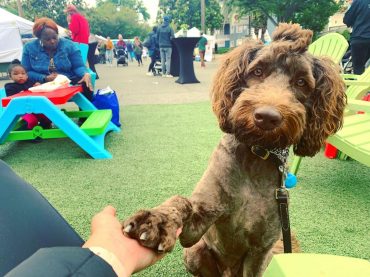
Make sure they test their breeding dogs to make sure that no genetic diseases would be passed on to their puppies, and be able to show you essential documents such as health clearances, to ensure they’re legitimate.
Meeting the parents and their litter shouldn’t be a problem as well, as it would let you observe that the dogs have sound temperaments. They should be curious and would welcome you with a wagging tail.
If the parental breeds and their litter seem aggressive or they’re cowering, it can mean that the pups would act and grow up fearful or hostile.
Don’t hesitate to let the breeder know what exactly you want in a dog. Since they know their canines better, they’d be able to help you choose the most suitable puppy for you and your family.
If you’re ready to start your search, here are some of the websites that have some cute Labradordoodle puppies for you:
- Crockett Doodles (Greenville, SC)
- Uptown Puppies (Lehi, Utah)
- Deer Creek Labradoodles (Owenton, KY)
- Rozey K9 Farm (West Michigan)
Always Consider Adoption
There are a lot of dogs, including Labbidoos, that end up in shelters or back to their breeders because some people would buy a puppy without even learning and understanding what it means to own one.
If you’ve already checked with your local shelter, but you want to check online for other dogs who are in need as well, we hope this helps:
- Mountain Park Labradoodles (Oregon)
- Goldendoodle and Labradoodle Rescue (Reinholds, PA)
- IDOG Rescue (Houston, Texas)
Is the Labradoodle the Right Dog For You?
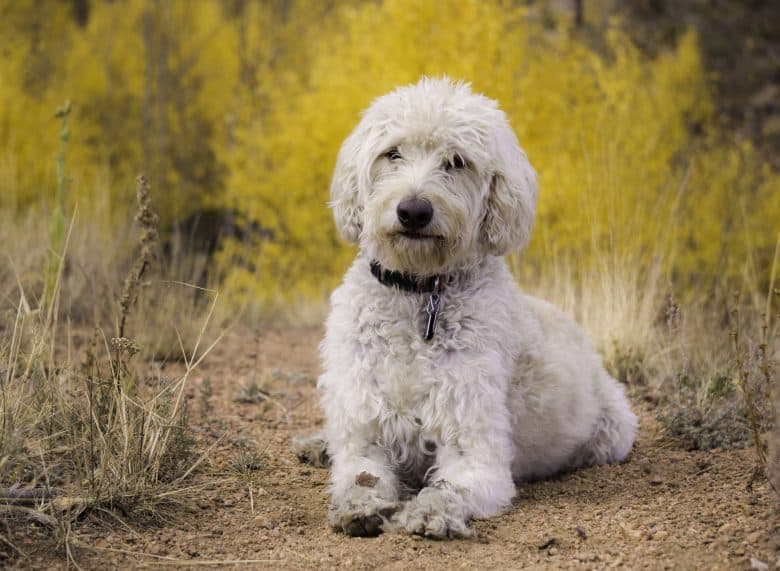
Although Lab and Poodle mixes aren’t 100% allergy-friendly, they proved themselves as great therapy and guide dogs. Families particularly desire this Doodle, but they are also suitable for first-time dog owners!
Although the Labradoodle looks like a cute stuffed animal, they’re excellent companions that are lovable, loyal, witty, and amusing! Since they can get a bit hyper, keep an eye on them whenever they’re playing with little kids and smaller dogs.
Apartment living isn’t the kind of home they’d thrive in because they would need to have a place where they can freely play and exercise at the same time.
If you have dog allergies, pick a Labradoodle that has a wool or fleece coat, which tends to be hypoallergenic, and stay away from the hair type.
After learning the essential facts about the Labradoodle and you’re confident that you can be a proud owner of this crossbreed, then congratulations! You finally found the doodle for you!
What are your thoughts about the Poodle and Labrador Retriever mix? Share your stories about buying or adopting one, how much you like this breed, and any advice or tips related to Labbidoos. Feel free to let us and the other readers know by commenting on the box below!
Further reading: Other Adorable Doodles
Cess is the Head of Content Writing at K9 Web and a passionate dog care expert with over 5 years of experience in the Pet Industry. With a background in animal science, dog training, and behavior consulting, her hands-on experience and extensive knowledge make her a trusted source for dog owners.
When not writing or leading the K9 Web content team, Cess can be found volunteering at local shelters and participating in dog-related events.
